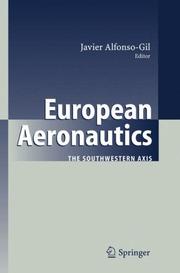| Listing 1 - 3 of 3 |
Sort by
|

ISBN: 1280957573 9786610957576 3540356479 3540356460 364207135X Year: 2007 Publisher: Berlin : Springer,
Abstract | Keywords | Export | Availability | Bookmark
 Loading...
Loading...Choose an application
- Reference Manager
- EndNote
- RefWorks (Direct export to RefWorks)
The book covers both the analysis of the major producer of civil aircraft (EADS/Airbus) located in the region and its relation with the cluster of enterprises within those regions. We studied the organization of production, the creation of knowledge within the industry, the concentration and competition among the two global producers, the overall financial situation of the sector, the specialization and specification of the different territories. The book also analyzes the basic theoretical aspects needed to understand the origin and evolution of the European aerospace sector from the first dreamers to the beginning of this century. To end, the book shows a descriptive and inference statistical analysis of each territory.
Aerospace industries --- Aircraft industry --- EADS (Firm) --- European Aeronautic Defence and Space Company --- Airplane industry --- Aviation industry --- Airplanes --- Industries --- Regional economics. --- Management. --- European Economic Community lite. --- Engineering. --- Regional/Spatial Science. --- Innovation/Technology Management. --- European Integration. --- Automotive Engineering. --- Construction --- Industrial arts --- Technology --- Administration --- Industrial relations --- Organization --- Economics --- Regional planning --- Regionalism --- Space in economics --- Spatial economics. --- Industrial management. --- European Economic Community literature. --- Automotive engineering. --- Business administration --- Business enterprises --- Business management --- Corporate management --- Corporations --- Industrial administration --- Management, Industrial --- Rationalization of industry --- Scientific management --- Management --- Business --- Industrial organization --- Spatial economics --- Regional economics --- EADS N.V. --- Airbus (Firm)
Book
ISBN: 3039217275 3039217267 Year: 2019 Publisher: MDPI - Multidisciplinary Digital Publishing Institute
Abstract | Keywords | Export | Availability | Bookmark
 Loading...
Loading...Choose an application
- Reference Manager
- EndNote
- RefWorks (Direct export to RefWorks)
One might say that ordinary differential equations (notably, in Isaac Newton’s analysis of the motion of celestial bodies) had a central role in the development of modern applied mathematics. This book is devoted to research articles which build upon this spirit: combining analysis with the applications of ordinary differential equations (ODEs). ODEs arise across a spectrum of applications in physics, engineering, geophysics, biology, chemistry, economics, etc., because the rules governing the time-variation of relevant fields is often naturally expressed in terms of relationships between rates of change. ODEs also emerge in stochastic models—for example, when considering the evolution of a probability density function—and in large networks of interconnected agents. The increasing ease of numerically simulating large systems of ODEs has resulted in a plethora of publications in this area; nevertheless, the difficulty of parametrizing models means that the computational results by themselves are sometimes questionable. Therefore, analysis cannot be ignored. This book comprises articles that possess both interesting applications and the mathematical analysis driven by such applications.
heteroclinic tangle --- n/a --- coupled system --- integral boundary conditions --- EADs --- transport --- bifurcation analysis --- SIR epidemic model --- ion current interactions --- green’s function --- surface of section --- endemic equilibrium --- age structure --- MATCONT --- Ulam’s stability --- nonlinear dynamics --- stability --- basic reproduction number --- green's function --- Ulam's stability
Book
ISBN: 3039211641 3039211633 Year: 2019 Publisher: MDPI - Multidisciplinary Digital Publishing Institute
Abstract | Keywords | Export | Availability | Bookmark
 Loading...
Loading...Choose an application
- Reference Manager
- EndNote
- RefWorks (Direct export to RefWorks)
Modern biology is rapidly becoming a study of large sets of data. Understanding these data sets is a major challenge for most life sciences, including the medical, environmental, and bioprocess fields. Computational biology approaches are essential for leveraging this ongoing revolution in omics data. A primary goal of this Special Issue, entitled “Methods in Computational Biology”, is the communication of computational biology methods, which can extract biological design principles from complex data sets, described in enough detail to permit the reproduction of the results. This issue integrates interdisciplinary researchers such as biologists, computer scientists, engineers, and mathematicians to advance biological systems analysis. The Special Issue contains the following sections:•Reviews of Computational Methods•Computational Analysis of Biological Dynamics: From Molecular to Cellular to Tissue/Consortia Levels•The Interface of Biotic and Abiotic Processes•Processing of Large Data Sets for Enhanced Analysis•Parameter Optimization and Measurement
n/a --- inosine --- immune checkpoint inhibitor --- geometric singular perturbation theory --- simulation --- BioModels Database --- ADAR --- calcium current --- bifurcation analysis --- bacterial biofilms --- nonlinear dynamics --- explanatory model --- turning point bifurcation --- oscillator --- workflow --- bioreactor integrated modeling --- modeling methods --- elementary flux modes visualization --- multiscale systems biology --- evolutionary algorithm --- metabolic model --- differential evolution --- reduced-order model --- computational model --- gut microbiota dysbiosis --- canard-induced EADs --- computational biology --- metabolic modelling --- methods --- SREBP-2 --- mechanistic model --- systems modeling --- biological networks --- macromolecular composition --- provenance --- flux balance analysis --- immunotherapy --- compartmental modeling --- immuno-oncology --- metabolic network visualization --- mechanism --- bistable switch --- Clostridium difficile infection --- bioreactor operation optimization --- microRNA targeting --- CFD simulation --- biomass reaction --- RNA editing --- ordinary differential equation --- metabolic modeling --- mass-action networks --- hybrid model --- multiple time scales --- quantitative systems pharmacology (QSP) --- mathematical modeling --- microRNA --- cancer --- parameter optimization --- Hopf bifurcation --- breast
| Listing 1 - 3 of 3 |
Sort by
|

 Search
Search Feedback
Feedback About UniCat
About UniCat  Help
Help News
News